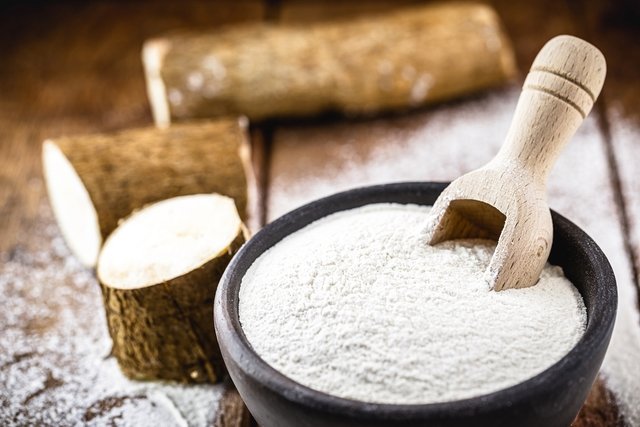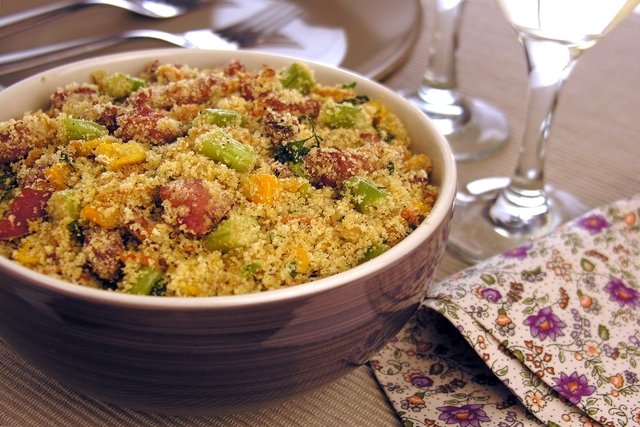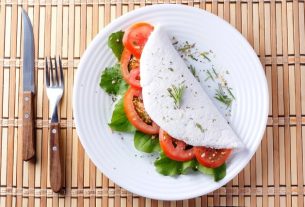Cassava flour has good amounts of minerals, in addition to being rich in fiber that helps balance blood glucose levels and prolongs satiety throughout the day, preventing diabetes and promoting weight loss.
However, cassava flour should be consumed in moderation as it is rich in carbohydrates that can make you fat, especially when consumed in preparations with a lot of fat, such as bacon farofa and fried foods, for example.
Also known as table flour, cassava flour has a mild flavor and can be consumed raw or roasted to accompany meals, but it can also be used to prepare recipes such as farofa, cake, porridge, mush, bread and biscuits.

Does cassava flour make you fat?
When consumed in large quantities, cassava flour can make you gain weight, as it is rich in carbohydrates that can increase the caloric value of the diet, favoring weight gain.
Furthermore, when used in preparations with a lot of fat, such as bacon farofa or fried foods, for example, cassava flour can also make you fat.
However, cassava flour has a low glycemic index, helping to control blood glucose and reducing hunger throughout the day. Therefore, when consumed in moderation and in healthy preparations, cassava flour helps with weight loss.
How to eat cassava flour without gaining weight
To enjoy the flavor and benefits of cassava flour without gaining weight, it is recommended to eat 1 to 2 tablespoons of this flour per day, which can be used in preparations such as salad, pancakes, omelets, bread, porridge and soup.
Furthermore, it is also recommended to consume cassava flour along with proteins, such as chicken, fish and eggs, and vegetables, as these foods help to reduce the glycemic load of the meal, promoting satiety and preventing weight gain.
Benefits of cassava flour
The main health benefits of cassava flour are:
- Improve physical and mental disposition, for having good amounts of carbohydrates;
- Avoid constipation, as it is rich in fiber that improves bowel function;
- Prevent cramps, because it has good amounts of potassium;
- Help prevent diabetes, because it has a low glycemic index, helping to control blood glucose levels;
- Promote weight loss, because it is rich in fiber that helps to prolong satiety throughout the day;
- Help prevent high blood pressure, due to its magnesium and potassium content.
Furthermore, cassava flour does not contain gluten, making it a good option to include in the diet of people with intolerance or sensitivity to gluten. See other gluten-free foods.
Nutritional information table
The following table provides nutritional information for 100 g of raw and roasted cassava flour:
However, to obtain the benefits of cassava flour, it is also essential to maintain a healthy diet and practice physical activity regularly.
Healthy cassava recipes

Cassava flour can be used in healthy and tasty recipes such as vegetable farofa and cake.
1. Vegetable farofa
Ingredients:
- 2 medium grated carrots;
- 2 small grated zucchini;
- 1 tablespoon of unsalted butter;
- 1 medium grated onion;
- 3 chopped garlic cloves;
- 2 cups of cassava flour;
- Chopped parsley to taste;
- Salt and ground pepper to taste.
Preparation mode:
In a frying pan, toast the cassava flour well over medium heat and set aside. In another frying pan, heat the butter, add the onion and chopped garlic, and sauté well.
Add the grated zucchini and carrot and sauté, stirring with a spoon, for 5 minutes. Add the toasted flour, salt and seasonings, mixing well until the farofa is very homogeneous. Wait for it to cool and serve.
2. Cassava flour cake
Ingredients:
- 1 cup (tea) of brown sugar or 1 teaspoon of culinary sweetener;
- 100 g of unsalted butter;
- 4 egg yolks;
- 1 cup of coconut milk;
- 2 and 1/2 cups of sifted raw cassava flour;
- 1 pinch of salt;
- 4 egg whites beaten to stiff peaks;
- 1 tablespoon of chemical baking powder.
Preparation mode:
Beat the sugar, or sweetener, butter and egg yolks in a mixer until creamy. Add coconut milk, salt and flour to the mixture, beating little by little.
Lastly, add the yeast and egg whites, stirring gently with a spoon until the dough is homogenized. Pour the dough into a greased pan and place in a preheated oven at 180ºC for around 40 minutes.
Bibliography
- UNIVERSITY OF SÃO PAULO (USP). Supplementary Tables Glycemic response. 2019. Available at: <http://www.tbca.net.br/arquivosestaticos/Tables_Complementares_Resposta_Glicemica_n.pdf>. Accessed on March 17, 2023
- CAMPINAS STATE UNIVERSITY. Brazilian Food Composition Table – TACO. 2011. Available at: <http://www.nepa.unicamp.br/taco/contar/taco_4_edicao_ampliada_e_revisada.pdf?arquivo=taco_4_versao_ampliada_e_revisada.pdf>. Accessed on Jan 6, 2022
- GUO, L, Haiqin Lu et al. Study on quality characteristics of cassava flour and cassava flour short biscuits. Food Science & Nutrition Food Science & Nutrition. Vol.8. 521–533, 2020
- OKAFOR, N, Ebelechukwu et al. Cassava Flour Substitution Modulates Glycemic Responses and Glycemic Index of Wheat Breads in Apparent Healthy Volunteers. Journal of Dietary Supplements. Vol.14. 4. ed; 446-452, 2017

Sign up for our newsletter and stay up to date with exclusive news
that can transform your routine!
Warning: Undefined array key "title" in /home/storelat/public_html/wp-content/plugins/link-whisper-premium/templates/frontend/related-posts.php on line 12
Warning: Undefined array key "title_tag" in /home/storelat/public_html/wp-content/plugins/link-whisper-premium/templates/frontend/related-posts.php on line 13




